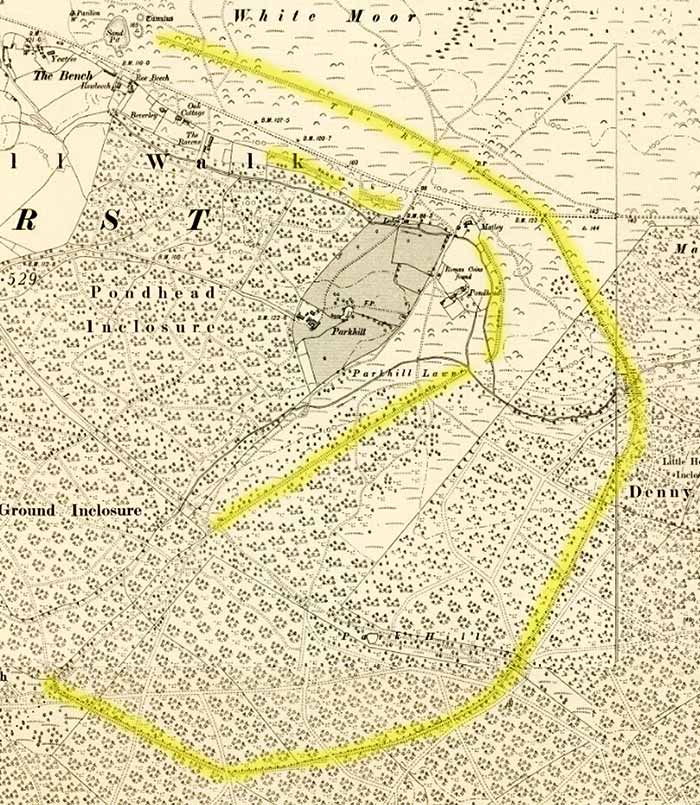The Park Pale and Lyndhurst Old Park
(Sections of the Park Pale can be explored during this 4½ mile New Forest walk and also during this slightly longer, 5½ mile New Forest walk).

trackway alongside Denny Inclosure
Introduction
When travelling along the Beaulieu Road, south-east of Lyndhurst, notice the substantial earthen bank intersected by the tarmac, just where the ground rises beyond the last house (A). It’s probably not a subject that exercises many peoples’ minds, yet this humble earthwork is at least 700 years old.
A bit of history
The earthen bank and accompanying internal ditch are part of the Park Pale that once enclosed what became known as Lyndhurst Old Park, a medieval deer park dating back to at least the 13th century – presence was first recorded in 1291, but even then, it was not new.
Despite many years of wear and tear, the bank and ditch in places are still an enormous 9 metres (29 feet) wide, whilst the bank is up to 1.2 metres (4 feet) high. Add the height of the paling fence that would inevitably have been present, and the whole would have been far too large for even the most energetic deer to leap, providing an extremely effective method of containing the deer within the confines of the park.
(Deer parks were almost certainly created to provide a readily accessible source of winter meat in the days long before refrigerators became available. In 1086, at the time of the Domesday survey, the existence of thirty-five such parks was recorded in parts of the country covered by the survey, and this number subsequently greatly increased.
Deer were encouraged to enter many of the parks over or through 'deer leaps', gaps in the fence or sections of fence of reduced height with adjacent steep ground on the park side, designed to prevent escape. An example of this type of feature is recalled by the names of Deerleap Inclosure and Deerleap Farm, both located close to the old New Forest boundary a little to the south-east of Ashurst).
By 1428, however, the park near Lyndhurst was reported to be poorly maintained, although disparking does not seem to have occurred until the 16th century, both, perhaps, following reduced interest in the deer. New Park, Brockenhurst, first noted in 1484, continued in use, however, and was extended in 1670 by King Charles II ‘for the preservation of our red deer, newly come out of France.’
The Park Pale - shape and location
The Park Pale encloses a flask-shaped area, with one broad, open end running alongside Park Ground Inclosure, and a narrow neck situated virtually between Beaulieu Road and, to the north, The Ridge.
It is not specifically shown on the late-18th century Richardson, King and Driver map, although its course can be traced in the line of the Lyndhurst parish boundary which here also coincides with the boundary of a New Forest Keeper’s Walk. Shown as a line of dashes, its semi-circular shape encloses Park hill Lawn, Botley Field and South Lawn; and skirts the southern and eastern edges of the accompanying map.
It is shown, however, on the 1871, 1898 and 1909 6 inches to the mile Ordnance Survey maps, but is not named, although it is clearly marked and named on modern Ordnance Survey maps. The 1909 Ordnance Survey map is shown below with the Park Pale highlighted in yellow.

The deer
Deer, it has been suggested, were driven in at the open end, and herded into the narrow neck to be summarily shot with bows and arrows, although recent research suggests that the original park was not flask-shaped at all, and was, in fact, considerably larger than the area now enclosed.
Today, three species of deer enjoy the freedom of the old park, all relatively unhindered. Fallow deer are most likely to be seen, but roe deer occur in reasonable numbers and, very occasionally, red deer, too. Slots and droppings reveal their presence, even if the animals themselves are not glimpsed.
References:
Discovering the New Forest: Terry Heathcote
Proceedings of the Hampshire Field Club & Archaeological Society, Volume 54 – The Earthwork Remains of Enclosure in the New Forest: Nicola Smith
The New Forest – A Natural History: Colin R. Tubbs
A Guide to the New Forest: Heywood Sumner
Deer Watch: Richard Prior
More links
Other related links
Search this site

Sadly, 58 animals were killed - 35 ponies, 13 cows, 8 donkeys and 2 sheep, whilst a further 32 were injured - 3 pigs, 9 donkeys, 11 cows and 9 ponies.
(Forty-three accidents occurred in daylight, 15 at twilight and 101 in the dark. Twenty-seven accidents were not reported by the driver involved).
Here's just one horrific example - Three donkeys killed in collision with van at notorious New Forest blackspot (Advertiser and Times)

